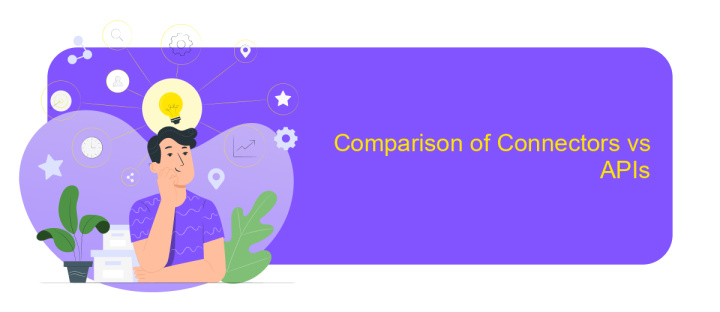Difference Between Connector and API
In the realm of software integration, understanding the distinction between connectors and APIs is crucial for developers and businesses alike. While both serve as vital tools for facilitating communication between systems, their roles and functionalities differ significantly. Connectors are pre-built solutions designed to link specific applications, whereas APIs provide a set of protocols and tools for building custom integrations. This article explores these differences to help you choose the right approach for your needs.
Introduction
In today's digital landscape, the seamless integration of various software systems is crucial for efficient business operations. Two key components that facilitate this integration are connectors and APIs. While both serve the purpose of enabling communication between different software applications, they function in distinct ways and are suited for different scenarios. Understanding the differences between connectors and APIs is essential for developers and businesses aiming to optimize their technology stack.
- Connectors: Pre-built solutions designed to link specific applications without requiring extensive coding.
- APIs: Sets of rules and protocols that allow developers to build custom integrations between software applications.
- Use Cases: Connectors are ideal for quick, out-of-the-box integrations, while APIs offer flexibility for tailored solutions.
By comprehending the unique roles of connectors and APIs, organizations can make informed decisions about which tool best suits their integration needs. Connectors provide a straightforward approach for rapid deployment, whereas APIs offer the customization necessary for complex requirements. Ultimately, the choice between using a connector or an API depends on the specific goals and resources of the organization.
What is a Connector?

A connector is a tool or software component that facilitates the communication and interaction between two different systems or applications. By translating data formats and protocols, connectors enable these systems to seamlessly exchange information, ensuring interoperability. They play a crucial role in integrating disparate systems, allowing businesses to streamline operations and improve efficiency. Connectors are often used in scenarios where direct integration is not feasible due to differences in technology or architecture.
In the realm of integration services, connectors can be pre-configured to work with specific applications, reducing the complexity of setting up integrations. For instance, services like ApiX-Drive offer a wide range of connectors that simplify the integration process between various platforms. By utilizing connectors, businesses can automate workflows and enhance data synchronization without the need for extensive coding or technical expertise. This not only saves time but also minimizes errors, providing a reliable solution for connecting diverse systems.
What is an API?

An API, or Application Programming Interface, is a set of rules and protocols that allows different software applications to communicate with each other. It serves as an intermediary, enabling applications to request and exchange data seamlessly. APIs are crucial in modern software development, allowing developers to integrate third-party services and functionalities into their applications without having to build them from scratch. This not only saves time but also enhances the capabilities of the software.
- APIs provide a standard way to access and manipulate data.
- They enable the integration of different systems and services.
- APIs enhance interoperability between disparate software applications.
- They allow developers to leverage existing services to build more robust applications.
- APIs help in maintaining security by controlling access to data and services.
In essence, APIs are the backbone of digital communication, enabling diverse applications to work together and share information effectively. They are used in a wide range of scenarios, from web services and cloud computing to mobile apps and IoT devices. By offering a structured way to interact with software components, APIs foster innovation and collaboration in the tech ecosystem.
Comparison of Connectors vs APIs

Connectors and APIs serve as essential tools for integrating different software systems, yet they operate in distinct ways. Connectors are typically pre-built integrations that allow applications to communicate seamlessly, often requiring minimal configuration. They are designed to simplify the connection process between platforms, making them user-friendly for non-developers.
APIs, or Application Programming Interfaces, provide a more flexible and powerful means of integration. They offer developers the ability to access and manipulate data or services within an application programmatically. APIs require a deeper understanding of coding and system architecture, but they allow for highly customized solutions tailored to specific needs.
- Connectors: Pre-configured, user-friendly, limited customization.
- APIs: Highly customizable, require coding skills, offer extensive functionality.
In summary, the choice between connectors and APIs depends on the level of customization and technical expertise required. Connectors are ideal for quick and straightforward integrations, while APIs are suited for complex and bespoke solutions. Understanding the specific needs of your project will guide you in selecting the most appropriate tool for integration.
- Automate the work of an online store or landing
- Empower through integration
- Don't spend money on programmers and integrators
- Save time by automating routine tasks
Conclusion
In conclusion, understanding the difference between connectors and APIs is crucial for businesses seeking to optimize their digital operations. Connectors provide a user-friendly interface that simplifies the integration process, allowing users to connect different applications with minimal technical expertise. On the other hand, APIs offer a more flexible and powerful solution for developers, enabling them to create custom integrations with greater control over the data flow and functionality. Each approach has its own strengths, and the choice between them depends on the specific needs and technical capabilities of the organization.
For businesses looking to streamline their integration processes without extensive coding knowledge, services like ApiX-Drive offer an ideal solution. ApiX-Drive provides ready-made connectors that facilitate seamless connections between various applications, saving time and reducing the complexity of integration tasks. By leveraging such services, companies can enhance their operational efficiency and focus on strategic growth rather than technical hurdles. Ultimately, whether opting for connectors or APIs, the goal is to create a cohesive digital ecosystem that supports business objectives and drives innovation.
FAQ
What is the main difference between a connector and an API?
Can connectors and APIs be used together?
When should I use a connector instead of an API?
What are the limitations of using connectors compared to APIs?
How can automation platforms assist with using connectors and APIs?
Do you want to achieve your goals in business, career and life faster and better? Do it with ApiX-Drive – a tool that will remove a significant part of the routine from workflows and free up additional time to achieve your goals. Test the capabilities of Apix-Drive for free – see for yourself the effectiveness of the tool.


